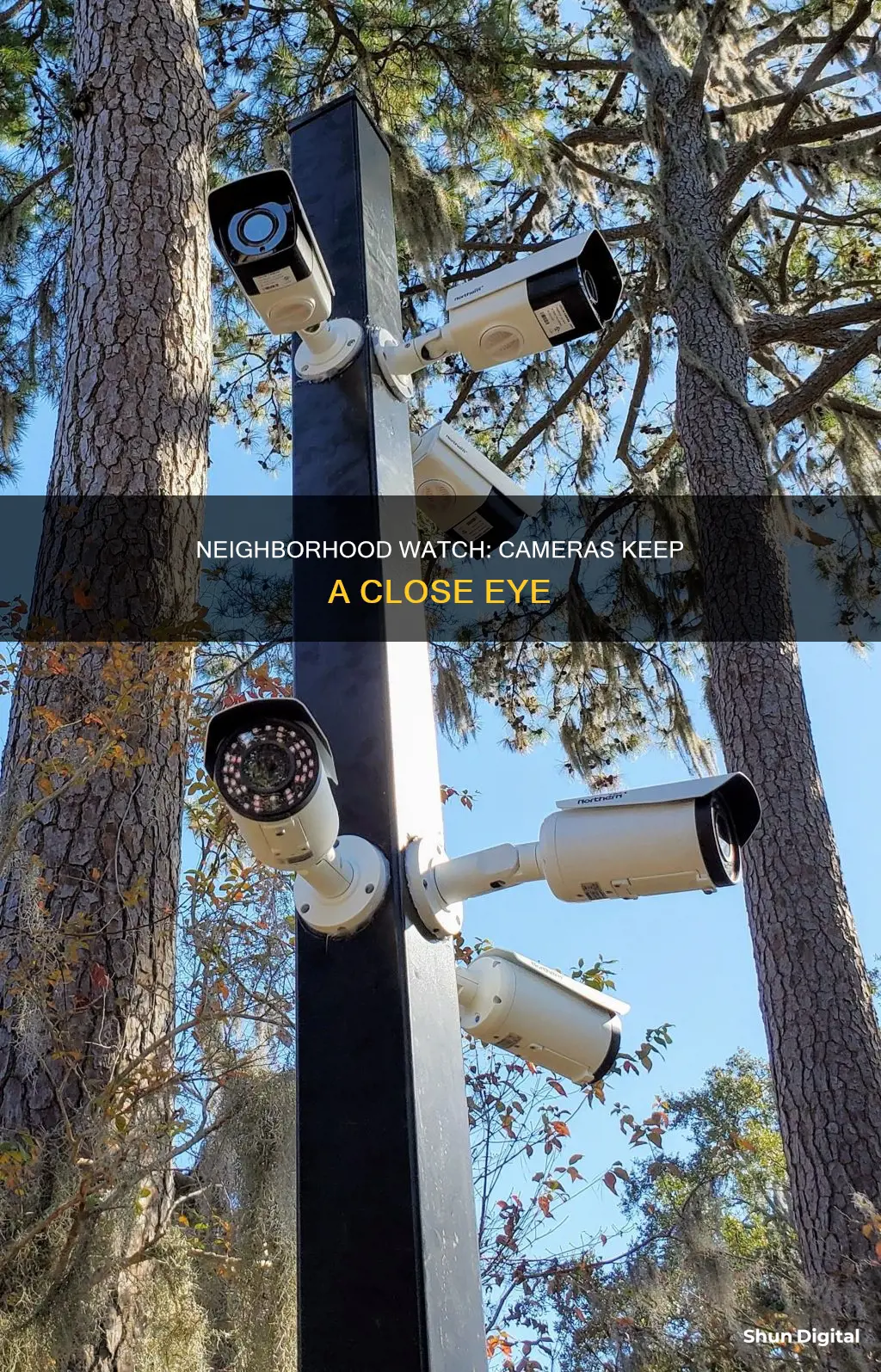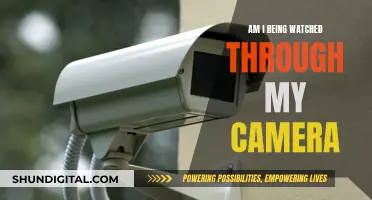
Neighborhood Watch is a community-led crime prevention initiative. It involves groups of civilians organizing to prevent crime and vandalism within a neighborhood. Neighborhood Watch groups work in conjunction with local law enforcement to reduce crime and improve the quality of life for residents.
While Neighborhood Watch programs are prevalent in the US, they are also found in other countries, including the UK, Australia, and China.
The initiative has evolved over the years to include the use of technology such as security cameras and license plate reading (LPR) cameras to aid in monitoring communities and deterring crime.
| Characteristics | Values |
|---|---|
| Purpose | Crime prevention and deterrence |
| Scope | Local, national, and international |
| Participants | Civilians, community members, volunteers, law enforcement |
| Activities | Patrols, meetings, educational programs, social activities, surveillance |
| Technology | CCTV, video doorbells, LPR cameras, cloud-based systems |
| Cost | Affordable, leasing options available |
| Benefits | Improved safety, community engagement, crime reduction |
| Limitations | Not a substitute for law enforcement, legal considerations |
What You'll Learn

How to set up a neighbourhood watch camera system
Step 1: Understand the Basics of a Neighbourhood Watch
A neighbourhood watch is a group of people living in the same area who want to improve safety and quality of life by working together and with local law enforcement to reduce crime. Neighbourhood watch groups have regular meetings to plan how they will achieve their goals and assign responsibilities.
Step 2: Form an Advisory Board
Select a 1-3 person advisory board to lead your neighbourhood watch group. This focused group will be able to make decisions and take actions that benefit the entire community more effectively than individual homeowners acting alone. The advisory board's first task is to establish clear goals for the community and find industry experts who can advise on effective ways to achieve those goals.
Step 3: Choose a Security Provider
Don't focus too much on the technology being used. Instead, choose an experienced security provider who can make the selected technology effective. The right provider will be able to tailor a security solution to your community's needs and budget.
Step 4: Select a Camera System
There are several types of camera systems that can be used for neighbourhood watch programs. Entry point surveillance involves monitoring all vehicles, occupants, and license plates entering and exiting the neighbourhood. Mobile surveillance trailers are another option and provide live monitoring and response but are the most expensive solution. Distributed cloud cameras are the most cost-effective solution and involve placing cameras in select homes to view the street and walkways, feeding video to a cloud-based surveillance system.
Step 5: Implement the Camera System
Work with your chosen security provider to implement the camera system. Ensure that all necessary infrastructure, such as power and communication options, are in place. Test the cameras to make sure they are functioning properly and providing clear video footage.
Step 6: Monitor and Respond
Once the camera system is in place, neighbourhood watch members can monitor the video feeds and respond to any suspicious activity. This may involve broadcasting live warning messages or dispatching the police if a crime is in progress. Members can also track unwanted visitors throughout the community and notify each other to deter or capture criminals.
Apple Watch Ultra: Camera in the Crown?
You may want to see also

The role of neighbourhood watch members
Neighbourhood watch groups are made up of volunteers who patrol their neighbourhoods for illegal activity. They act as the first line of defence in deterring crime and reporting suspicious activity. Members keep an eye out for any criminal activity or threats to residents, and report these to the police. They also work with law enforcement agencies to pass along information about crimes in specific neighbourhoods.
In addition to patrolling, neighbourhood watch members may also be involved in educational programs and other activities to raise awareness and target the root causes of crime. These can include drug awareness programs, tutoring, and sports clubs, especially for young people.
It is important to note that neighbourhood watch members should not carry weapons and should not approach or confront anyone. Their role is strictly to observe and report concerns to the local law enforcement agency.
By working together with local law enforcement, neighbourhood watch members can help to improve safety in their communities and reduce crime rates.
Are Street Signs Watched by Cameras?
You may want to see also

Benefits of neighbourhood watch groups
Neighbourhood Watch groups are a network of voluntary schemes established by local people to build and maintain safe and friendly communities. Here are some of the benefits of joining or starting a Neighbourhood Watch group:
Crime Reduction and Prevention
The primary benefit of Neighbourhood Watch groups is their role in reducing and preventing crime. By reporting suspicious activities to local authorities and increasing vigilance, these groups help create a safer environment for their communities. Research shows that Neighbourhood Watch programs can lead to a significant decrease in crime rates, with some studies indicating a 16% reduction in crime under the protection of these programs.
Improved Community Spirit and Unity
Neighbourhood Watch brings people together and fosters a sense of community. Regular meetings and collaborative efforts encourage neighbours to get to know each other, strengthening social connections and building unity within the neighbourhood. This sense of community can lead to increased pride and satisfaction with the area, improving the overall quality of life for residents.
Enhanced Security and Safety
The presence of Neighbourhood Watch groups provides an additional layer of security for residents, deterring potential criminals and increasing the likelihood of their apprehension. This heightened security leads to improved confidence and peace of mind for locals, allowing them to feel safer in their homes and neighbourhoods.
Education and Crime Prevention Resources
Neighbourhood Watch organisations often provide valuable resources and education on crime prevention. They offer guidance on improving home security, raising awareness about new forms of crime (such as cybercrime), and sharing tactics to make communities more resilient to criminal activities. This knowledge empowers residents to take proactive measures to protect themselves and their properties.
Strengthened Relationship with Law Enforcement
Neighbourhood Watch groups work in collaboration with local police forces, improving relationships between residents and law enforcement. This partnership facilitates better communication, information sharing, and coordination, making law enforcement efforts more effective and responsive to the community's needs.
PennDOT Cameras: Live Access and Availability for Viewers
You may want to see also

How neighbourhood watch groups work with law enforcement
Neighbourhood watch groups are an important part of the community, working to prevent crime and improve safety in residential areas. These groups work closely with law enforcement to achieve their goals, and their activities are diverse and varied, depending on the needs of the community. Here's how neighbourhood watch groups typically work with law enforcement:
- Reporting Criminal Activity: The primary role of neighbourhood watch members is to observe and report criminal activity or suspicious behaviour to law enforcement. They are encouraged to be vigilant and report their concerns to the appropriate authorities without intervening or taking matters into their own hands.
- Information Sharing: Neighbourhood watch groups serve as a conduit between law enforcement and the community. They receive information about burglaries, thefts, and other types of crimes from law enforcement and disseminate it within the neighbourhood. This helps residents stay informed and vigilant.
- Patrolling Neighbourhoods: In some cases, neighbourhood watch groups may organise patrols within their communities. These patrols are not meant to replace law enforcement but rather to act as an extra set of eyes and ears. The presence of these patrols can deter criminal activity and improve the sense of security in the area.
- Community Engagement: Neighbourhood watch groups often distribute crime prevention information, conduct home security surveys, and organise community clean-up events. They also play a role in welcoming new residents, fostering a sense of community, and encouraging residents to get to know each other. This helps create a network of attentive neighbours who can look out for each other.
- Meeting and Planning: Neighbourhood watch groups hold regular meetings to plan their activities and strategies. These meetings are also attended by law enforcement representatives, who provide guidance, training, and insights into the needs and dynamics of the community. They emphasise the importance of community involvement in crime prevention and share knowledge about identifying and reporting suspicious behaviour.
- Awareness and Education: Neighbourhood watch programs often include educational initiatives, especially for young people, to raise awareness and target the root causes of crime. These may include drug awareness programs, tutoring, sports clubs, and other activities that promote safety and security within the community.
- Cooperation with Law Enforcement: While neighbourhood watch groups work closely with law enforcement, they are instructed not to intervene directly in criminal matters. They are advised to avoid approaching or confronting suspicious individuals and to leave arrests and other law enforcement actions to trained officers. This is to avoid potential conflicts, lawsuits, and issues like false arrest or imprisonment.
- Testifying in Court: Since neighbourhood watch volunteers are often witnesses to crimes, they may be called upon to testify in court proceedings. Their observations and reports can provide valuable evidence to support law enforcement's efforts to bring criminals to justice.
- Adhering to Protocols: Neighbourhood watch groups are expected to follow established protocols and guidelines provided by law enforcement. This includes knowing when to call emergency services, how to submit reports, and how to deal with victims of crime. These protocols ensure that the group's activities are coordinated and aligned with official law enforcement practices.
- Technology and Surveillance: In recent times, neighbourhood watch groups have started incorporating technology, such as security cameras and video surveillance systems, to enhance their efforts. These tools provide remote monitoring capabilities and improve the group's ability to detect and report criminal activity. However, the use of weapons or any form of vigilante practices is strongly discouraged in neighbourhood watch programs.
By working collaboratively with law enforcement, neighbourhood watch groups contribute to crime prevention, community engagement, and the overall safety and well-being of their communities.
Accessing Live Wi-Fi Cameras on PC: Easy Steps
You may want to see also

The history of neighbourhood watch
The concept of neighbourhood watch, or crime watch, is one of the oldest and best-known crime prevention initiatives in North America. The roots of neighbourhood watch can be traced back to the Chicago School and its focus on the relationship between the social environment of a neighbourhood and crime. Research has shown that there is a link between areas with high crime rates and neighbourhoods characterised by a heterogeneity of economics and ethnicity, high levels of population turnover, and other physical and economic conditions.
In the late 1960s, an increase in crime heightened the need for a crime prevention initiative focused on residential areas and involving local citizens. The National Sheriffs' Association (NSA) responded by creating the National Neighbourhood Watch (NNW) program in 1972 to assist citizens and law enforcement. The program was also inspired by Jane Jacobs' book, "The Death and Life of Great American Cities" (1961), which stated that Americans need to keep their "eyes on the streets" and connect with each other in their neighbourhoods.
In the aftermath of the September 11, 2001 terrorist attacks, strengthening and securing communities became even more critical. Neighbourhood watch programs rose to the challenge, expanding beyond their traditional crime prevention role to help neighbourhoods focus on disaster preparedness, emergency response, and terrorism awareness. In 2002, the NSA, in partnership with other organisations, launched USAonWatch, the revitalized Neighbourhood Watch initiative, which represents the expanded role of watch programs throughout the United States.
Neighbourhood Watch Australasia (NHWA) was introduced to Australian communities by police in the 1980s. The logo, featuring four faces, was designed in 1983 and has become the nationally recognised brand of NHW. NHWA was established in 2006 to provide a collaborative approach to resource development, training, cross-sector information exchange, and advocacy for Neighbourhood Watch in Australia and Neighbourhood Support in New Zealand.
Streaming Roku Camera Footage to Your TV
You may want to see also
Frequently asked questions
A neighborhood watch is a group of civilians who work together and with local law enforcement to prevent crime and improve safety in their community.
A neighborhood watch on camera is a neighborhood watch program that utilizes security cameras to monitor the community for criminal activity. This can include license plate reading (LPR) cameras, doorbell cameras, and other types of surveillance equipment.
A neighborhood watch on camera can provide 24/7 monitoring of a community, even when residents are not at home or able to report suspicious activity themselves. Security cameras can also provide unbiased evidence, helping to ensure a fair and ethical investigation process.
Setting up a neighborhood watch on camera typically involves recruiting volunteers, selecting block captains, registering the group with local law enforcement, scheduling patrols and meetings, distributing contact information and procedures, and placing neighborhood watch signs. It is also important to select the right security camera equipment and work with a reputable company that specializes in neighborhood watch security.







